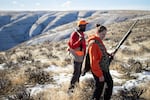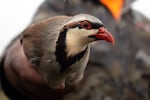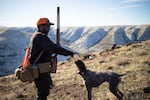Eric Thompson steps out of his truck and scans the horizon — rolling shrub-steppe dusted with snow as far as the eye can see, a typical scene for the Oregon desert in late fall. Another vehicle pulls up behind him and two people get out: his nephew Kyle Thompson and Lyndsay Ober, Kyle’s girlfriend. A feisty puppy hops out after them and begins darting around playfully.
They are searching for the best location to begin their daylong journey. Eric takes one last glance at the barren grassland before turning to his nephew.
“I’m just trying to see which way the wind is blowing,” he says.
Kyle waves his hand toward the east.
“I think it’s blowing that way,” he says.
Eric prefers being downwind from the animals he’s tracking. The group is braving the December climate in this remote landscape for one reason: chukar hunting.
Chukars are small partridges common in the desert regions of the Columbia Plateau. Native to Eurasia, they were introduced as a game bird to the United States in the early 1900s. Chukars prefer to roost on sloped, rocky terrain, which makes them notoriously difficult to hunt, and most hunters won’t even try without a dog.
“I enjoy chukar hunting because of the challenge,” Eric says. “It’s not an easy thing to do.”
The puppy assisting this crew is a German wirehaired pointer named Sky. Wirehairs are specifically bred for hunting, but Sky is still learning the intricacies of the sport. Even so, her presence will be invaluable.

Eric Thompson and Sky cross the snow covered shrub-steppe.
Noah Thomas / OPB
“It’s important to travel with a hunting dog because their nose is thousands of times more sensitive than yours,” Eric says. “They will find a bird where you might walk around for an hour and never find it.”
The U.S. Bureau of Land Management oversees approximately 15 million acres of public land in Oregon. This vast expanse, most of which is available for hunting and fishing, is a true luxury for outdoor enthusiasts like Eric.
“It’s the joys of living on public land,” he says. “I don’t know where I’d be if I didn’t live somewhere where I could just walk out and hunt.”
Reconnecting with the outdoors
The crew methodically preps necessary gear for the journey. It’s early morning, and they plan on covering several miles of terrain and wrapping up just before sundown. They’re carrying shotguns loaded with birdshot ammunition — a staple for bird hunters.
Eric grew up in Salem in a household where hunting was not just a hobby but a cherished family tradition. For him, hunting is more than just pursuing game; it is a way to immerse himself in the beauty of the great outdoors and rediscover his connection with nature.
“I like to say that I’ve walked most of Oregon,” he says. “I’ve fished, I’ve hunted, I’ve picked up rocks, I’ve looked at mushrooms. I’ve observed my natural world in minute detail.”

Kyle Thompson, left, and Lindsay Ober take a break on a chukar hunting trip in Sherman County on Dec. 12, 2022.
Noah Thomas / OPB
Kyle grew up following in the footsteps of his father and uncle and has now become a seasoned hunter in his own right. Ober, on the other hand, has never experienced bird hunting before, making this outing a completely new and exciting adventure for her.
“I’ve been trying to do this hunting thing since I met Kyle,” she says. “I’ve always loved to camp and stuff like that, so this is just right up my alley.”
The journey begins
The three hunters begin their trek at the rim of Cottonwood Canyon on the John Day River. The tranquil silence is only interrupted by the crunching sound of boots on snow. Eric notices something on the ground and stops to take a closer look — chukar prints.
“I’m seeing tracks,” he says. “I’d say these are at least a day old cuz they’re iced in. That’s the joy of hunting chukars in the snow: You get to see all the tracks.”
Not far into their journey, the hunters decide to make their descent down into the canyon. While chukars can sometimes be found on higher, more level ground, they’re much more likely to roost among the scree and rocks lining the canyon walls.

Kyle Thompson, left, and Lindsay Ober spread out to cover more ground while hunting chukars in Sherman County on Dec. 12, 2022.
Noah Thomas / OPB
The hunters space themselves out in order to cover more ground. Eric stays on top at the rim and Ober heads to the middle about 20 yards below. Kyle volunteers to take on the low ground in the canyon, which is usually considered the most challenging terrain to navigate, but also presents the greatest opportunity for finding birds.
“The birds will normally get over the lip where it’s harder to get,” he says. “So I’m the guy who always goes to the worst spots. We’ll see if it pays off today or not.”
From here on out, the group will be traversing sloped, uneven terrain — not an easy task when carrying 20 pounds of gear. Even for experienced hunters, pursuing chukars is often a difficult and treacherous feat, and one that Eric relishes.
“Chukars will run on you. They will tire out your dogs. They will tire you out,” he says. “They will break you on the hills trying to catch up with them.”
Picking up the scent
After nearly three hours of walking, the hunters know that chukars are close. They’ve left a very distinct clue.
“If you look down, you’ll see something that looks like a green and white ice cream cone,” Eric said. “And that’ll be chukar poop.”
He stops for a moment to scan the canyon ridge, almost as if he can sense the presence of birds a short distance away. He points ahead to a bend in the canyon wall.
“They’re somewhere near here,” he says. “We just gotta find where they’re roosting.”

Eric Thompson holds a domesticated chukar partridge that he uses for dog training in Sherman County on April 7, 2023.
Noah Thomas / OPB
Sky picks up a scent and begins sweeping the landscape, intently sniffing the air as she goes. Although she’s only been on a couple bird hunts, her instincts start to kick in as she focuses on her most important task: tracking chukars. Eric, who also raises and trains hunting dogs, understands that these early hunts are excellent learning opportunities for puppies like Sky.
“She’s working the scent,” he says. “She’s found something interesting and that’s what keeps her doing her job.”
From his spot lower in the canyon, Kyle spots a bird flying in the distance. He’s also started to hear their unique song, which is how chukars got their name.
“It’s like they’re saying chuk-a, chuk-a, chuk-a,” he says. “It sounded like 20 or 30 of them.”
In the blink of an eye
Continuing to work the scent, Sky is now roughly 50 yards ahead of the three hunters. Every few moments she pauses and does what German wirehairs are known for: pointing. By aiming her nose in a particular direction, she indicates to the hunters where the birds are located.
“Sky is on point right now,” Eric says. “Up, there they go!”
Suddenly, a flock of about 20 chukars flies toward the other side of the canyon. Even when flying they blend in seamlessly with the terrain. The birds are too far away for the hunters to take a shot.
“The birds were way outta range,” Eric says. “We wait for good shots.”
The hunters continue to walk, but slower and more deliberately. They know another opportunity could present itself at any moment.
And then it does.

Eric Thompson gives German wirehaired pointer, Sky a drink in Sherman County, Ore., in December 2022.
Noah Thomas / OPB
“There they go!” Eric shouts.
Another covey begins to fly past the hunters. This time they are within range, and both Eric and Kyle take aim and fire a couple rounds.
“Dead bird!” Eric shouts. “Good girl.”
He immediately praises Sky for a job well done. It’s because of her that he and his nephew are able to each get a successful kill. The entire chain of events happens in the blink of an eye.
Kyle makes his way to the dropped bird and scoops it up off the ground.
“We had already kicked a few out, but the dog was telling us there were a few still there,” he says. “So I was able to get a beat on it and got lucky.”
It’s not uncommon for chukar hunters to come back empty-handed, so nabbing two birds halfway through the hunt is definitely an accomplishment.
After a brief rest, the group continues their trek. As the midday sun beams down on them, Eric pauses at a lookout on the canyon ridge, taking a moment to admire the view.
“Oregon is just so steeped in my blood,” he says. “I’ve experienced so much joy and happiness in the outdoors here.”
He then looks down at Sky who’s excitedly wagging her tail. She looks up at him and lets out a whimper, eager to continue the journey.
“Come on girl,” he says. “Let’s keep moving.”


